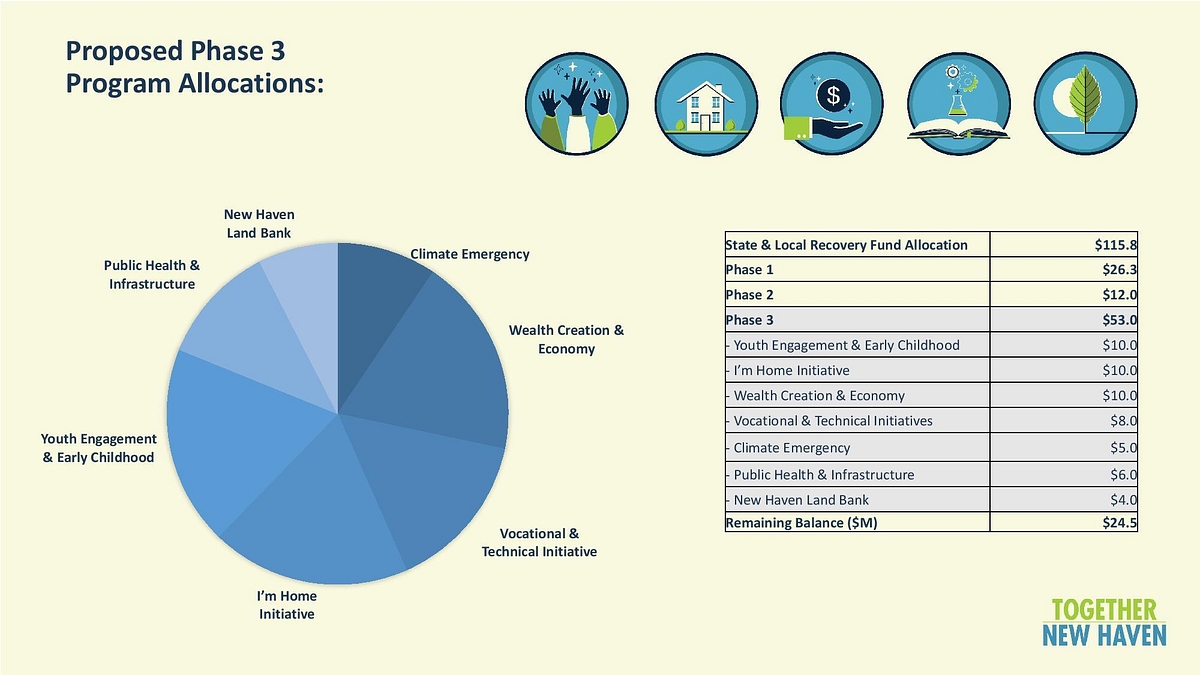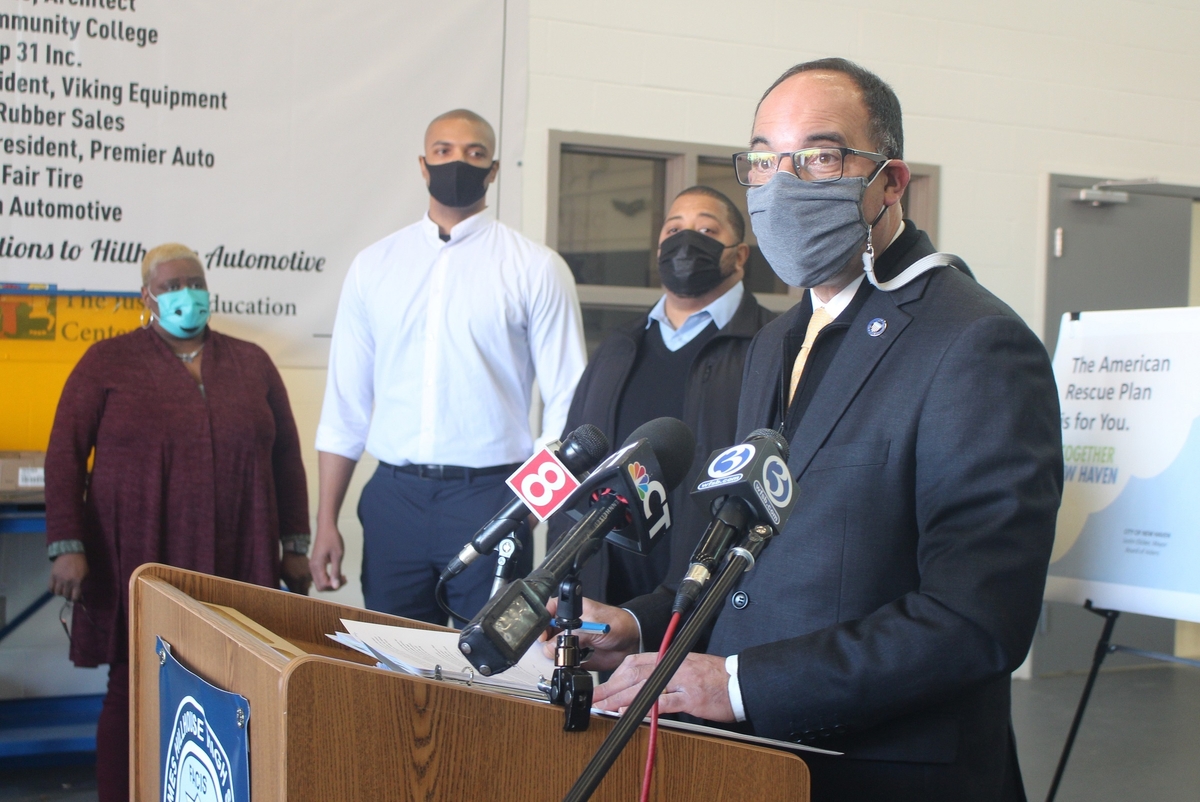
City of New Haven image
The Elicker Administration's proposed $53M ARPA spending plan.

City Economic Development Administrator Mike Piscitelli at least week's ARPA presser.
The mayor has formally submitted to the Board of Alders for review a proposed $53 million spending plan that would direct a bulk of the city’s remaining federal pandemic-relief aid towards a hodgepodge of housing, vocational technical education, youth engagement, business support, and climate resiliency initiatives.
Mayor Justin Elicker submitted that proposed spending plan as a communication to the Board of Alders as part of the local legislature’s Tuesday meeting agenda.
The proposal, which the mayor and top city officials first unveiled last week, will next be discussed during a public hearing by at least one aldermanic committee — and, likely, the City Plan Commission — before returning to the full Board of Alders for further debate and a potential final vote.
Click here, here, here, and here to read some the documents included as part of Tuesday’s communication.
The $53 million in question would come from the roughly $115 million the city is receiving thanks to the federal American Rescue Plan Act (ARPA). Click here, here and here for articles about roughly $38 million worth of ARPA-aid spending plans that have already been proposed by the Elicker Administration and approved by the Board of Alders.
In a cover letter written to Board of Alders President Tyisha-Walker Myers on Jan. 14, Elicker wrote that the initiatives included in this “Phase 3” proposed $53 million allocation arose out of months’ worth of public meetings, surveys, and interviews that the city conducted regarding how New Haveners would like to see this once-in-a-generation federal aid spent.
He summarized the key areas covered by this $53 million spending plan as Youth Engagement and Early Childhood, Vocational and Technical Initiative, Housing for All, Climate Emergency, Wealth Creation through Economic Development, Public Health and Parks and Open Space, and a new New Haven Land Bank.
He said his administration proposes to keep a balance of $24.5 million in ARPA aid “as a reserve for future investments, recognizing that other funding sources may not materialize for worthy projects and other needs may emerge in light of the ongoing public health emergency.”
“The Phase 3 process has also helped us to learn from history to address systemic and institutional racism,” Elicker continued in that cover letter, “develop our own leadership intentionally within local communities and organizations, work with an abundance mindset and an openness to possibilities and strive for accountability to the residents of New Haven in part by committing to foster anti-racist visionary spaces now and well into the future.”
How That $53M Would Be Spent

City of New Haven images

Below is a detailed breakdown of how the Elicker Administration plans to spend this $53 million, as quoted directly from the proposal submitted to the Board of Alders:
1. Youth Engagement & Early Childhood: $10 million
1.1 Youth Engagement Fund: Funding to be used to cover [1] Seasonal Staffing, including funding of the youth employment program and staffing for the recreational programming; [2] Programming, including funding of programming for youth of all ages and their families through the New Haven Department of Youth and Recreation; and [3] Staffing, including funding of full-time staffing to support implementation of youth engagement programs.
1.2 Early Childhood Fund: Funds to be used for early childcare workforce development through education to career pipeline and business support through promoting affordable homeownership for family providers. Funds will also be used to build common application and family subsidy portal to ease access for families looking for services. Funds will also support expansion grants for existing providers to extend hours of operations and/or capacity.
1.3 Youth Centers: Funding to be used for the development, programming / services and operation of new and existing youth centers with priority on reuse of existing space where feasible and with the goal of increasing coverage where feasible.
2. I’m Home Initiatives: $10 million
2.1 Neighborhood Development Initiative: Funds to be used in furtherance of wealth creation through affordable homeownership and may be used for down payment assistance; closing costs and support for acquisition and development of single-family and two-family dwellings as well as accessory dwelling units for impacted homeowners.
2.2 Fair Housing Fund: Funds to be used to support technology upgrades and program management for residential license inspections, Fair Rent Commission and gap financing for development projects with affordable housing components, including projects with a supportive housing component.
2.3 Rental Assistance Fund: Funds to be used to offset the cost of housing for impacted or disproportionally impacted households who are not currently receiving state or federal housing assistance. Funds may be used in conjunction with Financial Services Center (see 3.3) in part to support housing navigators, development of an affordable unit registry and Fair Housing programs.
3. Wealth Creation & Economy: $10 million
3.1 Small Business Fund: Funds to be used to provide direct grant support to small businesses and organizations supporting small business, with particular emphasis on Black- and Latinx-owned businesses. The application process will focus strategies to address negative economic impacts of the COVID-19 pandemic with robust outreach to ensure that eligible businesses are encouraged to apply with a low barrier to entry. Examples of support include small grants for physical upgrades to facilities, modernization initiatives, cultural equity and technical support to expand existing technical support services to Black and Latinx businesses including small contractors in the construction sector. These services will include technical assistance to increase access to institutional capital and recovery programs, as well as legal, marketing and networking assistance.
3.2 Economic Resiliency Fund: Funds to be used for larger grants in support of recovery through innovation and start-up business development all designed to address negative impact or improve economic competitiveness. Priority funding will be deployed on a matching basis with other sources for economic development initiatives including business, innovation and real estate project development.
3.3 Financial Services Center: Funds to be used to support the Financial Empowerment Center to grow and more intentionally market existing banking, debt management and financial planning programs to underserved communities. Examples of expenses including outside contractor support, addition of staff of up to five (5) counselor/navigator position, planning, strategy and partnership development activities.
3.4 Arts and Culture: Funds to be used to support creative entrepreneurs through small business technical, marketing and financial assistance consistent with the Cultural Equity Plan.
4. Vocational & Technical Development Initiative: $8 million
4.1 Vo-Tech Initiative: Funds to be used to launch a comprehensive Vo-Tech Initiative with the goal of creating vocational and technical school together with a training and entrepreneurial pipeline that guides New Haven residents through the process of attaining living wage careers in growing industries. Examples of programs to be supported include pre-development and feasibility of a new vocational-technical school, middle-college vocational and technical programs, community navigators and mentors, entrepreneurial development and training for young adults. Funds may be used on a matching basis in a manner consistent with program goals.
5. Climate Emergency: $5 million
5.1 Carbon Free Future Program: Funds will be used for programs that will have a demonstrated carbon- and cost savings. Examples include energy efficiency measures for impacted or disproportionally impacted households residing in single‑, two- and three-family buildings, non-carbon based heating, cooling and insulating systems, demand responsive and smart metering systems and LED lighting. Specific funding to be set aside to train small construction contractors. Funding also will be used to support municipal government services through carbon reductions and cost savings initiatives, including municipally-owned assets, solar installations and rolling stock.
6. Public Health: $6 million
6.1 Covid Response and Health Safety Fund: Funds to support ongoing investments in the New Haven Public Health Department related to coronavirus response, public health initiatives and general services. Examples include funding for community outreach workers; lead abatement and prevention program support; Healthy Homes campaign and equipment to support general regulatory functions.
6.2 Parks and Public Spaces Fund: Funds to be used for capital improvements at parks and public spaces citywide, including public health measures in parks and areas designated for preservation, climate resilient infrastructure and upgrades to outdoor recreation opportunities.
7. New Haven Land Bank: $4 million
7.1 New Haven Land Bank: Funds to be used to establish and operate a new Land Bank to support government services and address negative economic impacts of the pandemic with the authority to accept real property by foreclosure, gift, exchange or other means for the purpose or rehabilitating the property and Connecticut Public Act 19 – 92 related to the appointment of a receiver to take possession of vacant, blighted property for the purpose of rehabilitation together with associated planning and administrative functions.



Except for vocational education; this is full of pork and patronage for politcal pals//